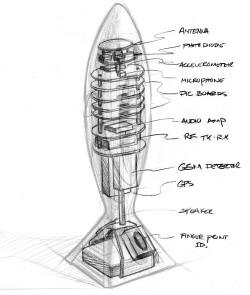![]()
Press
![]()
Links
Subscribe to Mailing List
Limelight
Local Sensing
Main Information Images Video Local Sensing Global Monitoring LinksThere are a variety of sensing hardware located onboard Limelight. A brief description of each sub-system is described below. Unmarked sensors are deployed in Phase-1 of Limelight. Those marked Phase-2 are under research and will brought into production during subsequent development.
Optical
Photocell optical detectors maintain a constant real-time measure on a wide portion of the electromagnetic spectrum. Primarily, visible, infrared, and ultraviolet, the optical sensors are located in the upper sensor portion of Limelight. Abnormalities and spectral patterns consistent with threatening events, actions, or known pre-threat conditions are noted and relayed to the central threat processing hardware for analysis.
Acoustical
Measuring a wide range of acoustic disturbances, the small, high-gain microphones are mounted within the upper sensing area. The acoustical system is capable of detecting audio fluctuations, reverberations, and sharp spikes as well as background noises beyond the range of the human ear. Monitoring and filtering sound signals, the sensing sub-system alerts the central threat processing hardware of sounds with characteristic profiles matching threatening vehicles, machines, ordinance, or sounds associated with known hostilities.
Temperature
Fluctuations in the ambient temperature near Limelight are registered with the central threat indicator. Abnormal heating or cooling curves over time that are inconsistent with natural and safe local events and activities are flagged high priority and delivered to the central threat processor.
Acceleration / Vibration
Subtle vibrations, sharp blows, and abnormal motions are identified by a highly sensitive 3-axis MEMS based accelerometer. Capable of measuring motions as extreme as ten times the force of gravity and as minor as 1/1000 gravity. Motion is simultaneously measured along three directions, allowing for richer interpretation of events near Limelight and improved threat indication accuracy.
Positioning and Localization
A vital element of determining local threat conditions is knowing the local position. Embedded global positioning hardware (GPS) and an antenna are used to record Limelight's current position. That data drives the proper selection of filters and weights to use on most of the other sensors. That is, the geography and local habitat of Limelight strongly dictates the relevance of various thread indicators. Each macro-location on the planet dictates that the system use the proper weightings and rules.
This location, recorded over time, is also used to generate profiles of transport and usage for both Limelight and its local user. Recall that the identity of the local user is known from the previously captured fingerprint acquisition hardware.
Radioactivity
There is a known direct relationship between the current threat and the locally measured emission of electrons, alpha particles, gamma rays, and beta rays. Limelight provides this important quantity to the threat system. Three distinct types of radiation are measured internally by Limelight:
Alpha Particles: Helium nuclei, generally emitted from heavy elements such as uranium and thorium.
Beta Rays: Electrons moving at extremely high (often relativistic) speeds. They are more penetrating than alpha particles.
Gamma Rays: Electromagnetic waves, similar to light, but at a much higher energy. Much more penetrating than alpha or beta radiations. High energy gamma rays can pass through several inches of metal. Note that X-Rays and Gamma Rays are really the same thing, the term X-Ray is used when the radiation is produced by electrons striking a material, such as in an X-Ray tube.
Counts of particles over time that exceed normal background radiation levels are relayed immediately to the central threat processor.
Radio Frequency Scanner (Phase-2)
Often early indicators of threat arise from monitoring various potions of the RF spectrum. For example, simple usage detection hardware is capable of sensing traffic on known local government, military, and emergency frequencies. It also monitors air traffic control frequencies. Traffic patterns inconsistent with normal usage are flagged for immediate inspection by the system. Similarly, noting transmissions and signal strengths from orbiting satellites furnishes important threat indicators.
Particular attention is paid to frequencies that broadcast data for covert operatives in hostile regions of the world. These stations transmit single use key encrypted streams of numbers providing orders to field reconnaissance units. You can listen to an actual capture of two such "number stations".
Number Station 1 (MP3)
Number Station 2 (MP3)Pressure / Barometric / Humidity (Phase-2)
Continuous pressure changes within the local environment.
Inclinometer (Phase-2)
Angle of tilt of Limelight.
Olfactory (Phase-2)
Measurement of small airborne particles as well as hostile gasses.
Magnometer and Direction / Compass (Phase-2)
Noting local magnetic field changes and calculating compass directions.
Flame (Phase-2)
Open flame near the system is detected.

 005_small.jpg)

